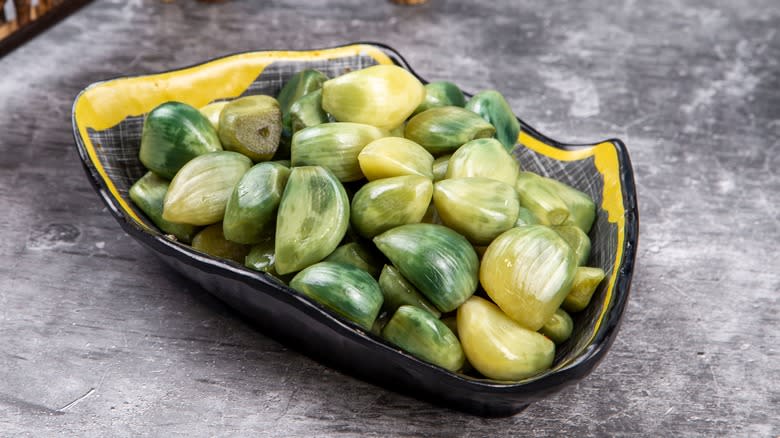What's Actually Happening When Your Garlic Clove Turns Green?

As hard as it is to imagine life without garlic, it has certain traits that leave us slightly repelled, confused, and even wary. One of its confounding trait is how garlic turns green, especially after it gets chopped. When that happens, it's natural to worry if it's still safe to cook with and eat. We're not talking about green sprouts in your garlic — we're talking about whole bulbs changing color.
Not to worry, though: The color change is simply due to the breakdown of the barriers between the garlic's sulfur compounds and enzymes called alliinase. No longer separated, these two components react to each other and with amino acids to form clusters of carbon-nitrogen rings called pyrroles. These rings appear in a specific color whenever light hits them, depending on the number of pyrroles present: Three-pyrrole molecules look blue, while four-pyrrole ones appear green; the latter has a similar structure to the chlorophyll molecule. That explains why combinations of garlic and onion sometimes appear blue as their enzymes mix. These molecules are safe to eat and don't negatively alter the taste of the garlic.
This chemical reaction happens more with older garlic since they've developed bigger quantities of sulfur compounds and alliinase. Ironically, cooking at a low temperature activates their enzymes so sauté garlic cloves quickly instead of sweating them to keep them from turning green in the pan.
Read more: 13 Unexpected Ingredients To Elevate Lasagna
The Greener The Garlic, The More Robust Its Flavor

One way of keeping garlic from turning green is by cooking it separately from certain ingredients. Since onions also contain sulfur compounds and enzymes, processing these ingredients together spurs each other's chemical responses. It is best to cook onions first to neuter their reactive components before tossing garlic in with them.
Another chemical reaction that happens whenever you chop garlic is the interaction between enzymes and amino acids. This results in the formation of allicin, the compound responsible for the spice's signature taste and odor. When allicin comes into contact with vinegar, the acetic acid in the liquid further dissolves the garlic's internal structure, facilitating the development of green pigments. To avoid this, let garlic cook completely before adding vinegar.
Garlic that has turned green may not be the most appetizing sight to some, but in northern Chinese cuisine, the vegetable is deliberately made green to make it more robust. Laba garlic is made by pickling peeled cloves in vinegar, salt, and sugar so its intensified flavor is layered with sourness, sweetness, and a bit of spiciness. The marinating period lasts anywhere between two and 20 days, and the longer it is, the more emerald-like the end result is. (Just don't panic if it turns blue.) Laba garlic is eaten as a tasty accompaniment to dumplings. Preserving this aromatic food in vinegar is also a great solution to having an older stash of garlic in the pantry, since pickled garlic lasts long when stored in the fridge. For more tips on how to max out your garlic, see our guide on how to get the most flavor out of your garlic.
Read the original article on Tasting Table